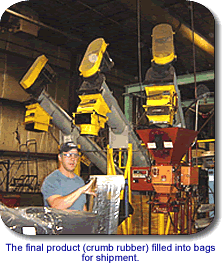Two doctoral students, Nongnard Sunthonpagasit and Elvin Yuzugullu recently visited the Chambersville, Pennsylvania facility of the tire recycling company LandStar. The site visit was part of the data gathering process of Nongnard's dissertation, titled "Impact of Market Variability of Crumb Rubber and Other Factors on the Economic Feasibility of Scrap Tire Recycling Facilities." The plant manager Gary Smith discussed the details of the process with Nongnard and Elvin and answered their questions.
The United States produces about 280 million tires annually. Less than 10% of waste rubber is reused, 40% is consumed as scrap in the production of Tire Derived Fuel (TDF), and the remainder of discarded tires is placed in landfills. Up till now, a significant amount of recycled rubber has not been used as a substitute for new or synthetic rubber, due to the inability of achieving desired properties. The rubber industry has concentrated more on the disposal of waste rubber rather than on recycling it. Consequently, there have been low volumes of recycling, buildup of tire stockpiles, and an industry with low profitability and business failures. Vehicle tires are the most noticeable of waste rubber products and the rate of their accumulation is startling.

LandStar is the largest producer of crumb rubber in the world and is the only producer in North America that has operations in multiple plants. The company uses methods like ambient grinding and wet grinding to recycle vehicle tires into high quality, reusable crumb rubber. The scrap tires are collected from various places, such as dealers, manufacturers, municipalities, and state agencies. The end product, crumb rubber, is used in a variety of applications, including asphalt rubber, playgrounds, running tracks, tire manufacturing, and automotive parts. Features of the crumb rubber like durability, water-resistance, elasticity and low cost make it an attractive material for use in various applications.
During the site visit, Mr. Smith initially walked the students through the facility and explained the steps of the process. The facility receives the tires in an already shredded form. The composition is a mixture of truck, bus, and automobile tires. The main goal of the process is to reduce the material in size and remove as much fiber and wire as needed. There are two basic processes: wet and dry. In the dry process, the shredded rubber goes through a series of mills and screeners, until the fiber and metals are removed and the desired size reduction is achieved. The quality of the process is assured by processing the material as many times as needed through the system until the desired size is reached. The crumb rubber, which is the end product, is filled into plastic bags and shipped to various customers. The wet process has the same structure, but it uses water in order to achieve more efficient results and aid in the process.



